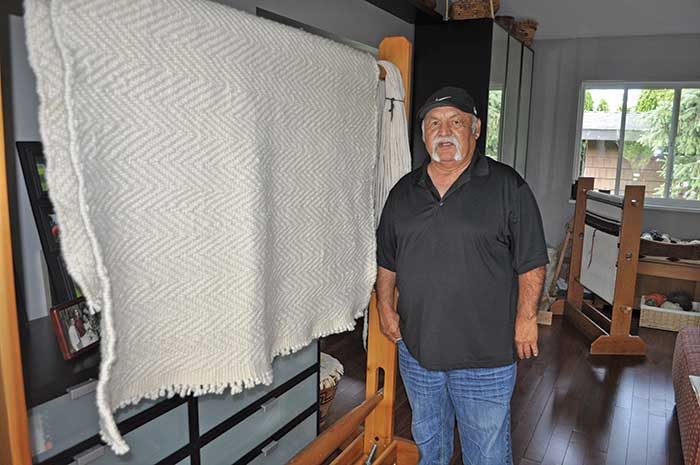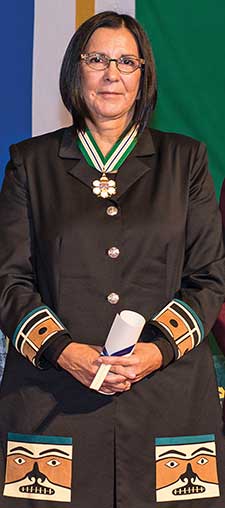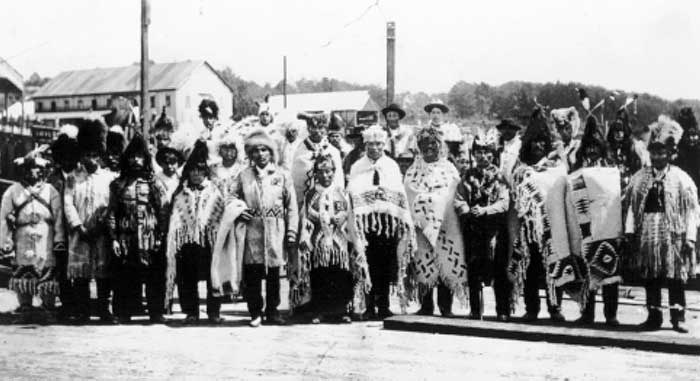The Blanket and the Bighouse
In modern-day Coast Salish longhouse ceremonies, the speaker calls witnesses and they are handed two quarters – 50 cents – in recognition of their role to remember and share the work about to take place. Those two quarters were once the price of a Hudson’s Bay blanket in the early days after European contact.
This was talked about when the Sentinel sat with Ray Harris of Stz’uminus and Wendy Grant-John of Musqueam recently, surrounded by wool weavings and bar looms in Grant-John’s home above the north arm of the Fraser River.
As they talked about the blanket, the gentle conversation grew to include things like currency before contact, the meaning of wealth, the relationships between men and women in the old Coast Salish society, equality and survival.
An important Coast Salish tradition was revived earlier this year in the longhouse at Kulleet Bay for a memorial held by the Harris family. Prominently displayed in a canoe between the fires, surrounded by a photograph, was a blanket woven by Wendy Grant-John.
When she was approached by Ray Harris to make the blanket, it brought memories of old traditions and methods. When she heard you could customize your blanket she simply couldn’t turn down the chance to do so.
Wendy: Something happened when I started talking to Ray, what that blanket should do.
In the old days, you were a high siem if you had a wife who had enough time to make all kinds of blankets. Blankets were piled as high as a child. What they would do is cut the blanket up and give the pieces away, the way the coppers were broken in some cultures.
I did four small weavings on the end (of the blanket) and they got cut off. Ray had one of the older women cut pieces off and gave them to prominent women around the bighouse in marking of the memorial for his daughter.
Ray: They cut that fringe in four pieces that went out to the audience and there was another fringe that they cut out and gave to me.
In the old days, it would be cut up in whatever number of pieces. Somewhere in the audience is a man or a family that’s going to do a big dance… he’s watching where these gifts went. Wherever these gifts went, he prepared himself and went and bought them back with trade goods or whatever, all the pieces of this sacred blanket, and rebuilt (rewove) them. It took four years to rebuild them.
There was no money then. This was the original currency. It had value, spiritual and financial value. Now the coins represent blankets. You could buy a Hudson Bay blanket for 50 cents, two quarters.
Wendy: The blankets and weaving were not just for show. They showed value of the man – his ability to take care of his wife so well, that she had time to weave. You showed your wealth by being able to cut those up.
Ray: If I cut it and gave it away, somebody’s going to come and buy it off you, for a year’s supply of salmon or whatever. The prestige followed the cuts that went out. You gladly accepted it and looked after it because somebody some day is going to knock on your door to buy it back.
Blankets before contact were called swuwqwa’l. They were made of mountain goat hair mixed with the hair of small dogs that were bred and herded specifically for that purpose. Duck down was also often spun into the hairs.
Simon Fraser (the European explorer) had writings about women who raised little white dogs. They were so particular about those dogs that they kept them on little islands to prevent cross-breeding. But blankets woven on the Salish loom began to disappear in the early 1900s.
Wendy: Salish weaving probably died around when my grandfather was 10. The last time he saw anybody doing it was in the bighouse. That happened because of the Cowichan sweaters coming, women switched to doing knitting.
I used to help wash wool and hand-card with my grandmother. I was interested as a little girl in what she was doing. One day we were sitting in the living room and grandfather said: “I’m going to show you something”. He went upstairs and came back with a cloth bag. He opened it up and there was a swuwqwa’l in there.
There were only three groups (of Indigenous people) that did bar-loom weaving at the time of contact. The Salish were the only ones doing the two-bar finger weaving. They created patterns that were comparable, and superior in my opinion, to the Navajo’s. The Tlingit do a completely different kind of weaving that hangs from a single bar. We were the only ones that did that type of weaving and it died very quickly.
Ray: Follow the wheel… there’s a real good story about the spinning wheel. The Coast Salish people probably invented the wheel before anybody. It’s a true story.
Wendy: I’m hoping it sparks some people in the bighouse when they see it (Ray’s blanket).
Ray: It carried on a custom that was real important to our people. Woven blankets defined the people, made the connections and kept the connections alive.
Wendy: Everybody did it, not just Musqueam; all the people in the Salish nation did it, but it died with the Hudson’s Bay blanket. We re-introduced it (in the 1980s) to Stz’uminus, Squamish… and now the Squamish women are going up to Tla’amin.
Ray: The longhouse… Everything used to take place there. I used it when I was chief.
Women made the decisions; the men would hang around. Men all sat in one section, women in another, deciding on things. Who’s going to get the ducks, who’s going to get the wood and all the other things?
Wendy: When I was a kid, I remember the women talking in the bighouse. Not in an overpowering way, but very forceful. We need to reclaim and own the teachings in order to move forward. It has been so perverted by the government.
This is really important for me, about men and women’s relationships in our old societies. The importance of women and they work they did was honoured and supported by the men.
After contact, women were subservient in the Western model of relationships. People talk about residential schools and the breakdown of the family and impact on children. I’ve always said that the impact on families is absolutely a horrific thing, but the more destructive was the relationship breaking between the men and the women.
White men demeaned women and put them in that role. We’ve had four or five generations of men who have come through that. And yet the matrilineal society was so strong here.
When Grant-John was 38, after just six months in politics as the Musqueam chief, she was becoming stressed out by the criticisms that were directed toward her by many male politicians and some women in leadership positions.
“I was ready to quit and couldn’t take it,” she said. But then she was invited to meet a group of culturally strong women.
Wendy: Ray’s mom (Irene Harris) and others invited me over to the Saanich bighouse and they shared with me. The native women’s organization said we were sell-outs to the men because I was regional chief then of the AFN and they said I was being subservient to the men.
The importance of women and their relationship with men was what they were talking about. She said to me, in our communities, our families followed together in the longhouse. That was the centre of who we were. And the relationship between the men and the women was the strength. Everything happened in the longhouse and you built your family in that longhouse.
Ray’s mother was so adamant. She said there is no one person above or below. They [men and women] are equal.
Women’s work, the spindle whorl, the loom. The men thought it so important, they wanted to make it beautiful for them. Wealth was created by women, really, because the men gave them enough time.
My grandfather told me, “You can’t do reconciliation if you don’t know the history and own it. You have a responsibility to help your people.
And you have a responsibility to help those white people understand what they did to us. But most important, you have to help those white people understand what they’ve done to themselves. The way they treated us; it was a reflection of what they did to us.”
Understanding is about the survival of the greater society…of all of us. Understanding the kind of societies we had here… the time has come.
What goes on in the bighouse was so strong it stayed. The longhouse is self-government in action. This is how communities make decisions.
Ray: Reconciliation, the longhouse, prominence of the ladies… I was so lucky to be a speaker. I learned the real important part of the speech is the response to it. And most of the heartfelt, sincere responses always came from the ladies.






